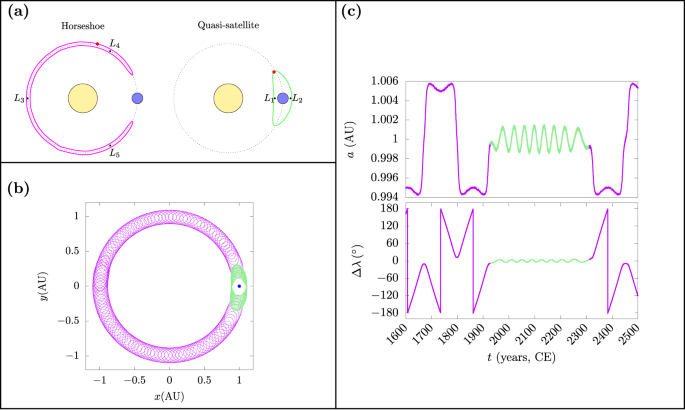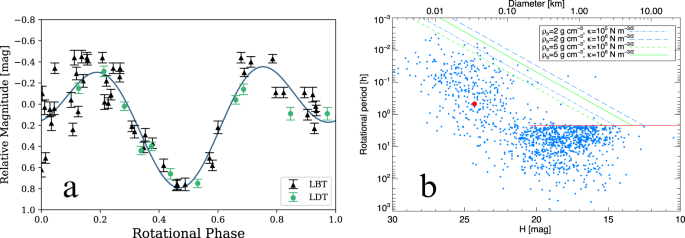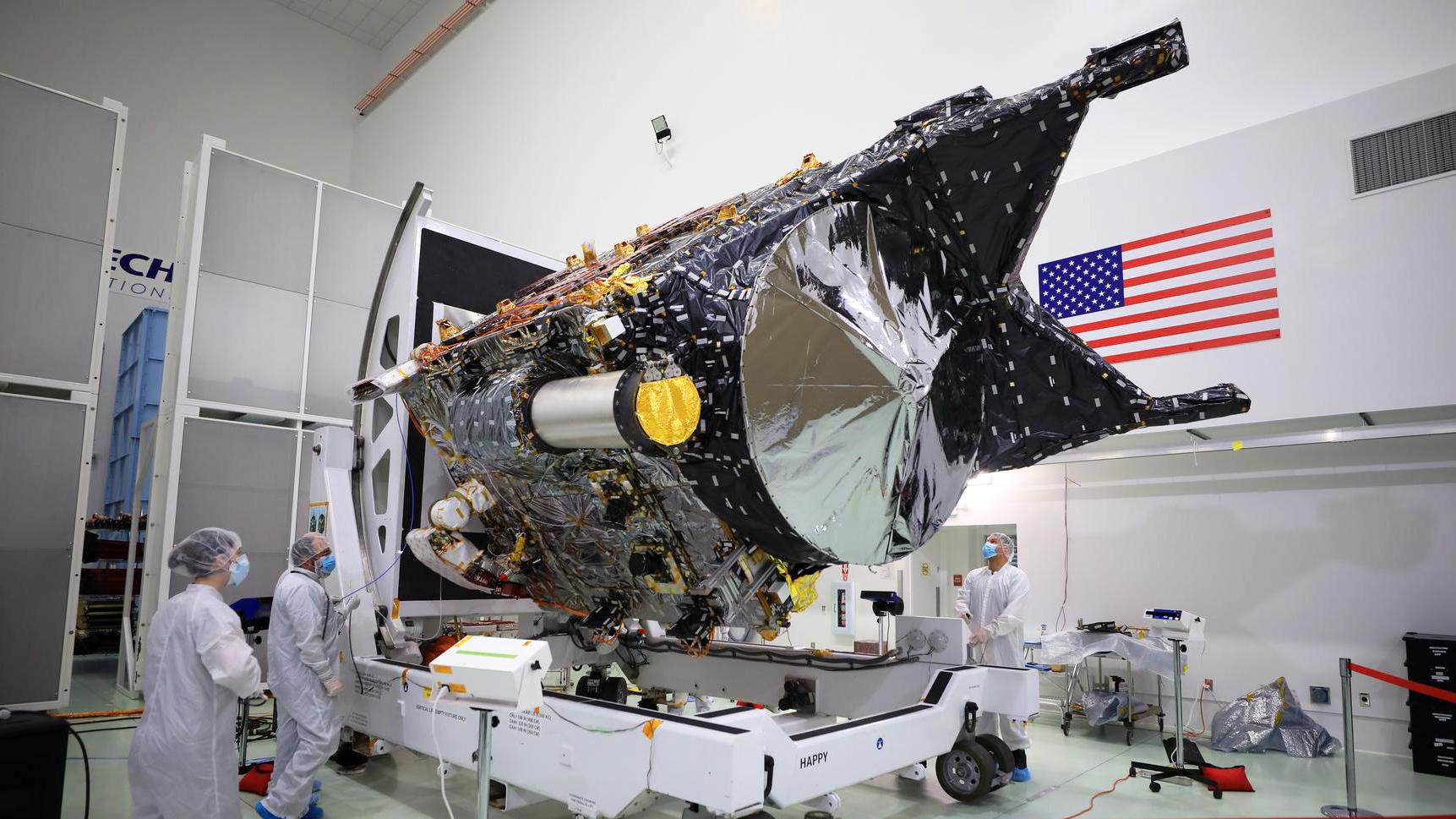2024-04-25 アリゾナ大学
<関連情報>
- https://news.arizona.edu/news/near-earth-asteroid-was-blasted-crater-moon-study-finds
- https://www.nature.com/articles/s41550-024-02258-z
- https://www.nature.com/articles/s43247-023-01031-w
- https://www.nature.com/articles/s43247-021-00303-7
月のジョルダーノ・ブルーノ・クレーターから地球への小惑星カモオアレワの旅 1:1共鳴 Asteroid Kamo‘oalewa’s journey from the lunar Giordano Bruno crater to Earth 1:1 resonance
Yifei Jiao,Bin Cheng,Yukun Huang,Erik Asphaug,Brett Gladman,Renu Malhotra,Patrick Michel,Yang Yu & Hexi Baoyin
Nature Astronomy Published:19 April 2024
DOI:https://doi.org/10.1038/s41550-024-02258-z

Abstract
Among the nearly 30,000 known near-Earth asteroids (NEAs), only tens possess Earth co-orbital characteristics with semi-major axes ~1 au. In particular, 469219 Kamo‘oalewa (2016 HO3), an upcoming target of China’s Tianwen-2 asteroid sampling mission, exhibits a meta-stable 1:1 mean-motion resonance with Earth. Intriguingly, recent ground-based observations show that Kamo‘oalewa has spectroscopic characteristics similar to space-weathered lunar silicates, hinting at a lunar origin instead of an asteroidal one like the vast majority of NEAs. Here we use numerical simulations to demonstrate that Kamo‘oalewa’s physical and orbital properties are compatible with a fragment from a crater larger than 10–20 km formed on the Moon in the last few million years. The impact could have ejected sufficiently large fragments into heliocentric orbits, some of which could be transferred to Earth 1:1 resonance and persist today. This leads us to suggest the young lunar crater Giordano Bruno (22 km diameter, 1–10 Myr age) as the most likely source, linking a specific asteroid in space to its source crater on the Moon. The hypothesis will be tested by the Tianwen-2 mission when it returns a sample of Kamo‘oalewa. And the upcoming NEO Surveyor mission may help us to identify such a lunar-derived NEA population
地球近傍小惑星Kamo’oalewaの月放出起源は稀な軌道経路と適合する Lunar ejecta origin of near-Earth asteroid Kamo’oalewa is compatible with rare orbital pathways
.Jose Daniel Castro-Cisneros,Renu Malhotra & Aaron J. Rosengren
Communications Earth & Environment Published:23 October 2023
DOI:https://doi.org/10.1038/s43247-023-01031-w

Abstract
Near-Earth asteroid, Kamo’oalewa (469219), is one of a small number of known quasi-satellites of Earth; it transitions between quasi-satellite and horseshoe orbital states on centennial timescales, maintaining this dynamics over megayears. The similarity of its reflectance spectrum to lunar silicates and its Earth-like orbit both suggest that it originated from the lunar surface. Here we carry out numerical simulations of the dynamical evolution of particles launched from different locations on the lunar surface with a range of ejection velocities in order to assess the hypothesis that Kamo‘oalewa originated as a debris-fragment from a meteoroidal impact with the lunar surface. As these ejecta escape the Earth-Moon environment, they face a dynamical barrier for entry into Earth’s co-orbital space. However, a small fraction of launch conditions yields outcomes that are compatible with Kamo‘oalewa’s orbit. The most favored conditions are launch velocities slightly above the escape velocity from the trailing lunar hemisphere.
地球準衛星(469219)2016 HO3 Kamoʻoalewaを形成する月類似のケイ酸塩物質 Lunar-like silicate material forms the Earth quasi-satellite (469219) 2016 HO3 Kamoʻoalewa
Benjamin N. L. Sharkey,Vishnu Reddy,Renu Malhotra,Audrey Thirouin,Olga Kuhn,Albert Conrad,Barry Rothberg,Juan A. Sanchez,David Thompson & Christian Veillet
Communications Earth & Environment Published:11 November 2021
DOI:https://doi.org/10.1038/s43247-021-00303-7

Abstract
Little is known about Earth quasi-satellites, a class of near-Earth small solar system bodies that orbit the sun but remain close to the Earth, because they are faint and difficult to observe. Here we use the Large Binocular Telescope (LBT) and the Lowell Discovery Telescope (LDT) to conduct a comprehensive physical characterization of quasi-satellite (469219) Kamoʻoalewa and assess its affinity with other groups of near-Earth objects. We find that (469219) Kamoʻoalewa rotates with a period of 28.3 (+1.8/−1.3) minutes and displays a reddened reflectance spectrum from 0.4–2.2 microns. This spectrum is indicative of a silicate-based composition, but with reddening beyond what is typically seen amongst asteroids in the inner solar system. We compare the spectrum to those of several material analogs and conclude that the best match is with lunar-like silicates. This interpretation implies extensive space weathering and raises the prospect that Kamo’oalewa could comprise lunar material.




